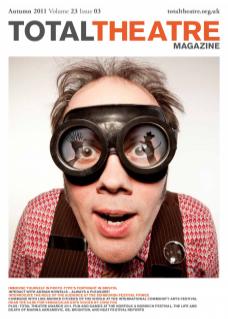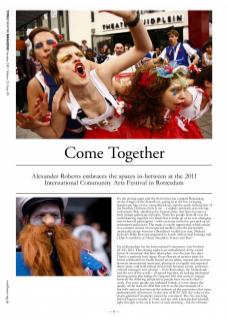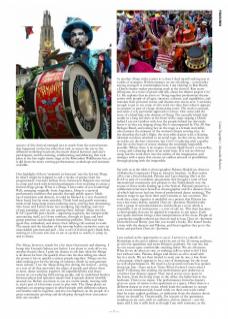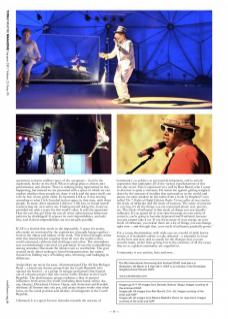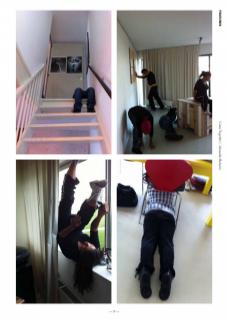It’s the closing night and the festival bar has erupted. Remaining on the fringes of the dancefloor, gazing in at the low-swinging, flamboyant hips of the young Brazilians, and the quick dancing feet of the Swedish-Chileans, there is me – a slightly awkward, arm-waving, enthusiastic Brit, absorbing the frenetic pulse that beats between a truly unique gathering of people. There are people from all over the world dancing together to a band that is made up of an ever-changing mix of festival participants – with everyone invited to just pick up an instrument and join in. The music is totally improvised, which results in a constant stream of unexpected medleys, like the particularly memorable merge between a Brazilian’s soulful jazz scat, Michael Jackson’s Billie Jean (accompanied by South African beat-boxing), and a Dutch rendition of ‘Head, Shoulders, Knees and Toes’.
I’m in Rotterdam for the International Community Arts Festival (ICAF) 2011. This closing night is an embodiment of the varied forms of encounter that have taken place over the past five days. There’s a tirelessly busy dance floor; flurries of creative ideas for future collaborations loudly shared across tables; musical jam sessions between international musicians, playing to an equally international dance party; and bold critical discussions between artists, audiences, cultural managers and scholars – from Rotterdam, the Netherlands and the rest of the world – all mixed together, all seeking ideological meeting points that bridge the frequent rifts that seem to emerge between the differing perspectives people have on each other’s work. For some people, me included I think, it is not always the quality of the work on offer that serves as the true measure of a festival’s success, but instead the richness of the encounters that occur spontaneously in-between. In the case of ICAF 2011 the value of the ‘un-programmed’ moments cannot be overstated. The five-day-long festival began everyday at 10am, and ran with a jam-packed schedule right through to the early hours of each morning – but the ultimate success of this festival emerged just as much from the conversations that happened on the bus rides that took us across the city to the different workshop locations; the meals shared between each day’s participants; and the dancing, collaborating and debating that took place at the late-night music stage at the Rotterdam Wijktheater bar, as it did from the many exciting performances, workshops and seminars available.
One highlight of these ‘moments in-between’ was the festival Murga. In what I might be tempted to call a ‘stroke of genius from the programmers’, Gerardo Salinas from Antwerp in Belgium was invited to come and work with festival participants every morning to create a festival Murga group. What is a Murga, I hear some of you wondering? Well, emerging originally from Argentina, Murga is a carnival performance tradition that parades through public spaces. Made up of musicians and dancers, it could be likened to a very theatrical brass band, but far more anarchic. Think loud and garish costumes; rattle-tattle bang-bang trance-inducing snare, and big bass drumming; Afro-beats and Latino brass; feet stomping, hip shaking, and a lot of arm pumping, and you are getting there. Salinas’ Murga was like ICAF’s guerrilla party-bomb – appearing regularly, but unexpectedly announcing itself, as if from nowhere, through its large and loud group presence and dramatic drumming preludes. Time and time again they ambushed, and always their rallying call seemed to work. The music and the freedom of the moving bodies seemed to carry an unavoidable gravitational pull – like a sort of festival-party black-hole, sucking in everyone who was in ear or eyeshot to watch, to jump in, and to dance.
The Murga, however, stands for a lot more than music and dancing. I bump into Gerardo Salinas just before I am about to rush off to see another theatre show. I grab my chance to ask him what the Murga is all about for him. He quickly dives into his idea telling me about the power it has to quickly connect people together: ‘Murgas are the ideal melting pot for the mixing of cultures, which in turn generate more culture.’ I see the Murga doing this during the festival – acting as a sort of oil that smoothes the edges of people and allows them to meet, dance and play together. Its unpredictability and chaos creates an even playing field among people, and its undefined borders between player and spectator means that it spreads almost invisibly around you. Before you know it, you are on the inside, moving with it, and a part of it becomes yours to play with. The Murga places an emphasis on creating spaces in which people with different cultures can breathe and be together, and also an emphasis on the people of a given community growing and developing through their encounters with one another.
As another Murga strike comes to a close I find myself seeking rest at a table of strangers. Within minutes we are all talking – conviviality among strangers is commonplace here. I am chatting to Ron Bunzl, a Dutch theatre-maker presenting work at the festival. Ron starts telling me, in a voice of gravel and silk, about his theatre project Circ/Us. He explains that its aim is to ‘bring together professional theatre artists with people of all ages, interests, cultures, and capabilities, and translate their personal stories and dreams into circus acts.’ I am lucky enough to get to see some of this work two days later when it appears in excerpts as part of a large showcasing event. The work is unusual, and takes a very particular approach to circus. One scene told the story of a blind lady who dreams of flying. The (actually blind) lady stands in a long red dress at the front of the stage singing a Dutch ballad I am not familiar with, but the people behind me obviously know it as they are singing along. She is accompanied by The All Star Refugee Band, and joining her on the stage is a female storyteller, who narrates the moment of the woman’s dream coming true. As she describes the lady’s flight, the storyteller dances with a floating, identical red dress attached to an aerial rope. In this circus, there are no tricks, no obvious virtuosity, but Circ/Us is playing with a quality that lies at the heart of circus: making the seemingly impossible possible. Where there is no trapeze to create flight there’s a storyteller, a song, and a dancing dress on an aerial rope. It is not an obvious swap, but the work dives into the realms of the imagination, and emerges with a space that creates an endless amount of possibilities through playing with the impossible.
Sat with us at the table is choreographer Paloma Madrid (co-director of Botkyrka Community Theatre, based in Sweden). As Ron rushes off to run a final rehearsal, Paloma and I get chatting. She’s at the ICAF as part of a residency programme that brought a total of four international community arts projects to the Netherlands over the course of three weeks leading up to the festival. Paloma’s project is a collaboration between herself as choreographer and five dancers (four of which had never had any form of professional dance training). The dancers range in age from their early twenties to late seventies. The work they create together is modelled on a project that Paloma has run a few times before, entitled Dance for Apartment. Madrid works with a group of untrained dancers and develops a score which is essentially a set of instructions – a sort of rule set. This then becomes a choreography that can be applied in response to any space. Each new space and time brings a new interpretation of the score. People of a particular neighbourhood are then invited to loan Dance for Apartment from their local library (just like you would a book). The loaner books a time with the dancers and Paloma, and then together they go to the home and perform Dance for Apartment.
I am excited at the opportunity to see it. I arrive in a suburb of Rotterdam at the given address with the rest of the 25-strong audience, go into the apartment and await Paloma’s guidance. No one sits, but no one seems quite comfortable standing either. We are all unsure. What do we do when no one, or nothing, tells us what to do? I feel lost without rules. Paloma obliges and invites us all to stand with her in a circle. We are then invited to read, one by one, a line from a document, which appears to be a sort of dramaturgy for the event we will all participate in. We read in a loop until everyone has spoken aloud one line – lines such as ‘Note: What if where I am is what I need?’ Following this reading, the performance gets underway as a further four dancers appear. They travel across every space in the house, from the living room to the office, the bathroom to the bedroom. There is no music. The performances from the dancers gives no sense of centre to the apartment as a space. Often there is a different dancer in every room, which leads the audience to occupy every room simultaneously, based solely on their own wish, rather than by some explicit guidance, or indication from the dancers about where we should be. Occasionally, I’m in parts of the apartment, standing on my own, with no audience, and no dancers – just the space and I, but it stills feels as though I am with someone, as the apartment contains endless traces of the occupants – food in the cupboards, books on the shelf. What is taking place is almost anti-performance; anti-theatre. There is nothing being represented in this happening, but instead we are presented with a space in which we can explore whether these people we share it with, and the space itself, can ever be free of any given order. In moments I felt as if was moving according to what I felt I needed in that space, in that time, with those people. In many other moments I did not. I felt lost, or found myself constructing my own safety net. Finding myself doing this, however, provided me with a sense for this work’s value. It asks the questions: How far can this go? How far can all of my subconscious behaviour patterns be challenged? It exposes its own impossibilities, and asks why, and if, these impossibilities are not actually possible.
ICAF is a festival that revels in the impossible. A space for artists, who make art motivated by the exploration of people being together – both as the object and subject of the work. This festival brought artists with this shared interest together from all over the world so they could commend, celebrate and challenge each other. The atmosphere was overwhelmingly convivial, yet polemical. It was this contradiction among attendees that made the whole event so worthwhile. The goal seemed rarely about seeking to breed homogenisation, but rather, focused on finding ways of holding onto, investing, and indulging in difference.
And politics are never far away. Aforementioned The All Star Refugee Band – a band cum theatre group from the Czech Republic who opened the festival – is a group of refugee performers that formed out of a theatre project that was run by Archa Theatre in the Czech Republic. The performance group combines a blur of musical influences from across the world (including brass band, ethno, ska, rap, klezmer, Dixieland, Chinese Opera, and Armenian and Kurdish rhythms) all thrown into one pot, and create theatre works that often focus on the social position and identity of immigrants in the Czech Republic.
Ultimately it is a quest for new attitudes towards the notions of ‘community’, to politics, to personal development, and to artistic expression that underpins all of the various manifestations of this five-day event. This is expressed very well by Ron Bunzl, who I come to discover is quite a visionary. He warns me against getting weighed down by the amount of troubles that surround us in the world, and passes on some wisdom he has taken from a book by Stephen Covey called The 7 Habits of Highly Effective People: ‘Covey talks of two circles: the circle of influence and the circle of concern. The circle of concern is very big, it’s all the things you are concerned about: war, poverty, etc. The circle of influence is that circle of things you can actually influence. If you spend all of your time focusing on your circle of concern, you’re going to become depressed and frustrated, because you just cannot take it on. If you focus more of your energy on your circle of influence, you realise there are a lot of things you can change right now – and through that, your circle of influence gradually grows.’
For a young theatre-maker, with wide eyes on a world of daily horror stories, it is invaluable advice to take onboard – a reminder to focus on the here and now, and to search for the changes that you can actually make, rather than getting lost in the enormity of all the issues that we as a global community are engulfed in.
Community is you and me, here and now…
The 5th International Community Arts Festival (ICAF) took place in Rotterdam, 30 March to 3 April 2011. ICAF is an initiative of the Rotterdam Neighbourhood Theatre, RWT. www.icafrotterdam.com
